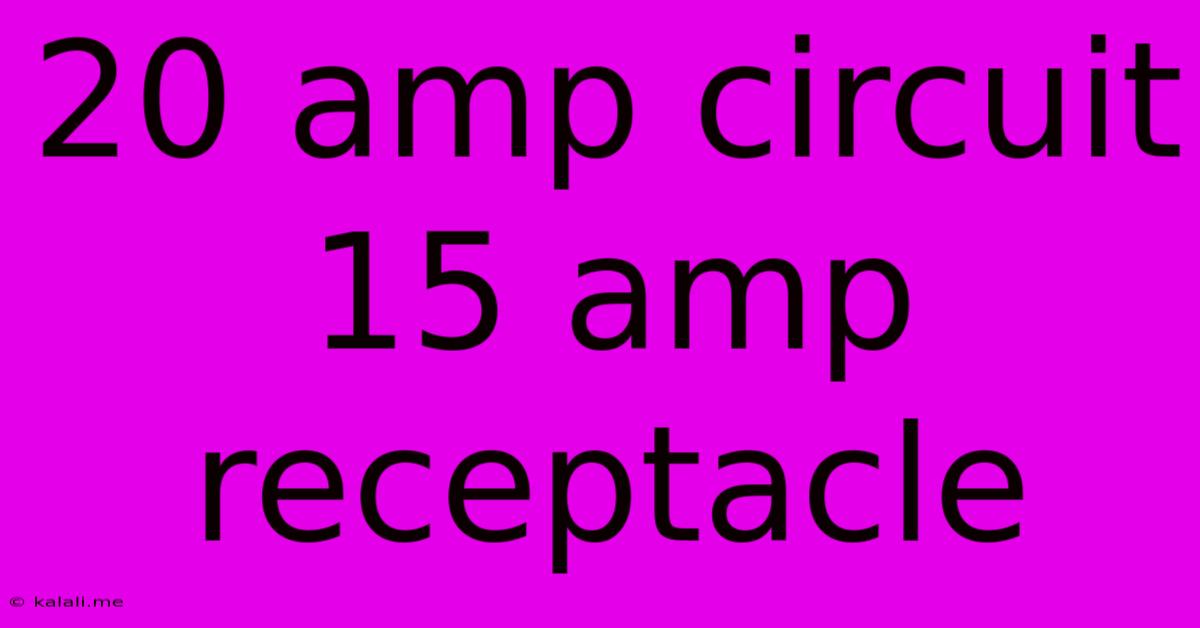20 Amp Circuit 15 Amp Receptacle
Kalali
Jun 10, 2025 · 3 min read

Table of Contents
20 Amp Circuit, 15 Amp Receptacle: Understanding the Safety and Code Compliance
Are you confused about running a 20-amp circuit with a 15-amp receptacle? This is a common question among DIY enthusiasts and homeowners undertaking electrical work. Understanding the relationship between circuit amperage and receptacle amperage is crucial for electrical safety and code compliance. This article will clarify the issue, explaining why this setup is generally acceptable and what precautions to take.
The Basics: Amperage and Circuit Protection
A circuit breaker protects the wiring in a circuit from overheating and potential fire hazards. A 20-amp circuit breaker trips when the current exceeds 20 amps. The receptacle is the outlet where you plug in your appliances. A 15-amp receptacle is designed to handle a maximum of 15 amps.
Why Use a 15 Amp Receptacle on a 20 Amp Circuit?
While it might seem counterintuitive, using a 15-amp receptacle on a 20-amp circuit is perfectly acceptable and, in many cases, the preferred practice. Here's why:
-
Code Compliance: Electrical codes, like the National Electrical Code (NEC), permit this configuration. The circuit breaker serves as the primary overcurrent protection. The receptacle's amperage rating simply indicates its physical capacity and doesn't override the circuit breaker's protective function.
-
Preventing Overload: A 15-amp receptacle isn't designed to handle the higher amperage a 20-amp circuit could potentially supply. Using a 15-amp receptacle on a 20-amp circuit effectively prevents overloading the receptacle itself. If a device drawing more than 15 amps is plugged in, the circuit breaker will trip before the receptacle is damaged.
-
Appliance Compatibility: Most household appliances and devices use 15-amp plugs. Using a 15-amp receptacle ensures compatibility with the majority of your appliances, reducing the need for specialized adapters. A 20-amp receptacle would be necessary only for high-amperage appliances that require it.
Important Considerations:
-
Wiring Gauge: Ensure that the wiring used for a 20-amp circuit meets the appropriate gauge requirements. Using undersized wiring can lead to overheating and fire hazards regardless of the receptacle type.
-
Circuit Breaker Selection: Always use a circuit breaker with an appropriate amperage rating for your wiring and the anticipated load.
When to Use a 20 Amp Receptacle:
While a 15-amp receptacle is often sufficient, you should consider a 20-amp receptacle in specific cases:
-
High-Amperage Appliances: Appliances with high power demands, such as some electric ranges, clothes dryers, and air conditioners, require 20-amp receptacles to safely draw the necessary current.
-
Multiple High-Power Devices: If you plan to regularly use multiple power-hungry devices on the same circuit, a 20-amp receptacle might be necessary to accommodate the total current draw without overloading the circuit.
-
Future-Proofing: In new construction or renovations, installing 20-amp receptacles provides flexibility for future high-power appliance needs.
In summary: Using a 15-amp receptacle on a 20-amp circuit is a common and safe practice, provided the wiring is correctly sized and the circuit breaker is appropriately rated. This setup ensures both code compliance and protection against overloads. However, understand the specific needs of your appliances and circuit requirements before finalizing your electrical installations. Always consult with a qualified electrician if you are unsure about any aspect of your electrical work. Electrical safety should never be compromised.
Latest Posts
Latest Posts
-
University Of Texas San Antonio Gpa Requirements
Jun 12, 2025
-
Uniformly Distributed Load Sample Problems With Solutions
Jun 12, 2025
-
What Is The Opposite Of Heavy
Jun 12, 2025
-
Sat Score For San Diego State
Jun 12, 2025
-
Power Bi Scenario Based Interview Questions And Answers
Jun 12, 2025
Related Post
Thank you for visiting our website which covers about 20 Amp Circuit 15 Amp Receptacle . We hope the information provided has been useful to you. Feel free to contact us if you have any questions or need further assistance. See you next time and don't miss to bookmark.